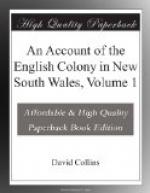[* A representation of this and other instruments is given in plate 11.]
It must be observed, that the principal tribes have their peculiar weapons. Most of us had made collections of their spears, throwing-sticks, etc. as opportunities occurred; and on showing them to our Sydney friends, they have told us that such a one was used by the people who lived to the southward of Botany Bay; that another belonged to the tribe of Cam-mer-ray. The spear of the wood tribes, Be-dia-gal, Tu-ga-gal, and Boo-roo-bir-rong-gal, were known from being armed with bits of stone, instead of broken oyster-shells. The lines worn round the waist by the men belonged to a peculiar tribe, and came into the hands of others either by gift or plunder. The nets used by the people of the coast for carrying their fish, lines, etc differed in the mesh from those used by the wood natives; and they extend this peculiarity even to their dances, their songs, and their dialect.
Among other customs which these people invariably practise, is one that is highly deserving of notice, as it carries with it some idea of retributive justice.
The shedding of blood is always followed by punishment, the party offending being compelled to expose his person to the spears of all who choose to throw at him; for in these punishments the ties of consanguinity or friendship are of no avail. On the death of a person, whether male or female, old or young, the friends of the deceased must be punished, as if the death were occasioned by their neglect. This is sometimes carried farther than there seems occasion for, or than can be reconcilable with humanity.




